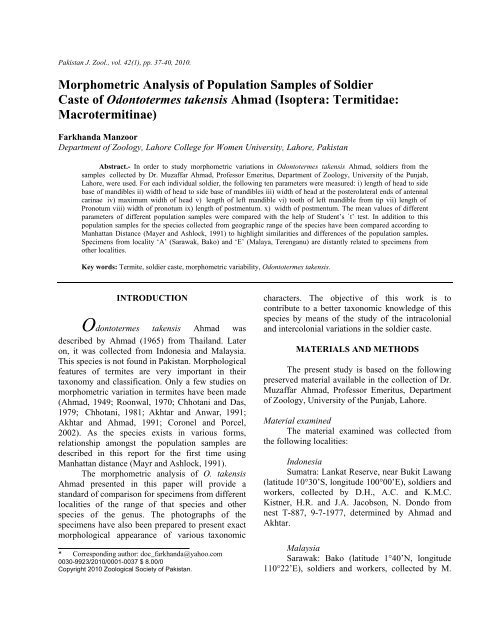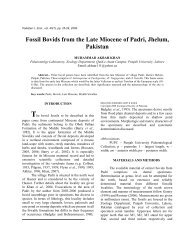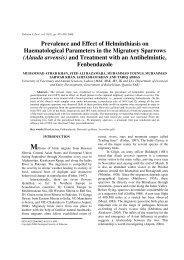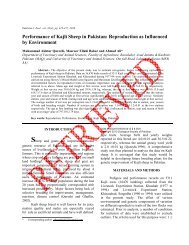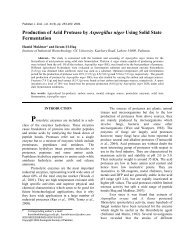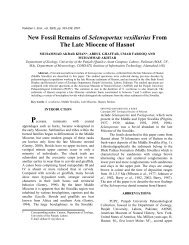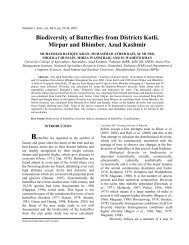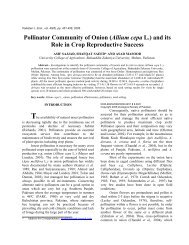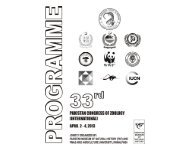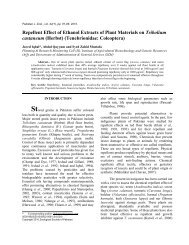Morphometric analysis of population samples of ... - Zsp.com.pk
Morphometric analysis of population samples of ... - Zsp.com.pk
Morphometric analysis of population samples of ... - Zsp.com.pk
- No tags were found...
You also want an ePaper? Increase the reach of your titles
YUMPU automatically turns print PDFs into web optimized ePapers that Google loves.
Pakistan J. Zool., vol. 42(1), pp. 37-40, 2010.<br />
<strong>Morphometric</strong> Analysis <strong>of</strong> Population Samples <strong>of</strong> Soldier<br />
Caste <strong>of</strong> Odontotermes takensis Ahmad (Isoptera: Termitidae:<br />
Macrotermitinae)<br />
Farkhanda Manzoor<br />
Department <strong>of</strong> Zoology, Lahore College for Women University, Lahore, Pakistan<br />
Abstract.- In order to study morphometric variations in Odontotermes takensis Ahmad, soldiers from the<br />
<strong>samples</strong> collected by Dr. Muzaffar Ahmad, Pr<strong>of</strong>essor Emeritus, Department <strong>of</strong> Zoology, University <strong>of</strong> the Punjab,<br />
Lahore, were used. For each individual soldier, the following ten parameters were measured: i) length <strong>of</strong> head to side<br />
base <strong>of</strong> mandibles ii) width <strong>of</strong> head to side base <strong>of</strong> mandibles iii) width <strong>of</strong> head at the posterolateral ends <strong>of</strong> antennal<br />
carinae iv) maximum width <strong>of</strong> head v) length <strong>of</strong> left mandible vi) tooth <strong>of</strong> left mandible from tip vii) length <strong>of</strong><br />
Pronotum viii) width <strong>of</strong> pronotum ix) length <strong>of</strong> postmentum. x) width <strong>of</strong> postmentum. The mean values <strong>of</strong> different<br />
parameters <strong>of</strong> different <strong>population</strong> <strong>samples</strong> were <strong>com</strong>pared with the help <strong>of</strong> Student’s `t’ test. In addition to this<br />
<strong>population</strong> <strong>samples</strong> for the species collected from geographic range <strong>of</strong> the species have been <strong>com</strong>pared according to<br />
Manhattan Distance (Mayer and Ashlock, 1991) to highlight similarities and differences <strong>of</strong> the <strong>population</strong> <strong>samples</strong>.<br />
Specimens from locality ‘A’ (Sarawak, Bako) and ‘E’ (Malaya, Terenganu) are distantly related to specimens from<br />
other localities.<br />
Key words: Termite, soldier caste, morphometric variability, Odontotermes takensis.<br />
INTRODUCTION<br />
Odontotermes takensis Ahmad was<br />
described by Ahmad (1965) from Thailand. Later<br />
on, it was collected from Indonesia and Malaysia.<br />
This species is not found in Pakistan. Morphological<br />
features <strong>of</strong> termites are very important in their<br />
taxonomy and classification. Only a few studies on<br />
morphometric variation in termites have been made<br />
(Ahmad, 1949; Roonwal, 1970; Chhotani and Das,<br />
1979; Chhotani, 1981; Akhtar and Anwar, 1991;<br />
Akhtar and Ahmad, 1991; Coronel and Porcel,<br />
2002). As the species exists in various forms,<br />
relationship amongst the <strong>population</strong> <strong>samples</strong> are<br />
described in this report for the first time using<br />
Manhattan distance (Mayr and Ashlock, 1991).<br />
The morphometric <strong>analysis</strong> <strong>of</strong> O. takensis<br />
Ahmad presented in this paper will provide a<br />
standard <strong>of</strong> <strong>com</strong>parison for specimens from different<br />
localities <strong>of</strong> the range <strong>of</strong> that species and other<br />
species <strong>of</strong> the genus. The photographs <strong>of</strong> the<br />
specimens have also been prepared to present exact<br />
morphological appearance <strong>of</strong> various taxonomic<br />
* Corresponding author: doc_farkhanda@yahoo.<strong>com</strong><br />
0030-9923/2010/0001-0037 $ 8.00/0<br />
Copyright 2010 Zoological Society <strong>of</strong> Pakistan.<br />
characters. The objective <strong>of</strong> this work is to<br />
contribute to a better taxonomic knowledge <strong>of</strong> this<br />
species by means <strong>of</strong> the study <strong>of</strong> the intracolonial<br />
and intercolonial variations in the soldier caste.<br />
MATERIALS AND METHODS<br />
The present study is based on the following<br />
preserved material available in the collection <strong>of</strong> Dr.<br />
Muzaffar Ahmad, Pr<strong>of</strong>essor Emeritus, Department<br />
<strong>of</strong> Zoology, University <strong>of</strong> the Punjab, Lahore.<br />
Material examined<br />
The material examined was collected from<br />
the following localities:<br />
Indonesia<br />
Sumatra: Lankat Reserve, near Bukit Lawang<br />
(latitude 10°30’S, longitude 100°00’E), soldiers and<br />
workers, collected by D.H., A.C. and K.M.C.<br />
Kistner, H.R. and J.A. Jacobson, N. Dondo from<br />
nest T-887, 9-7-1977, determined by Ahmad and<br />
Akhtar.<br />
Malaysia<br />
Sarawak: Bako (latitude 1°40’N, longitude<br />
110°22’E), soldiers and workers, collected by M.
38<br />
F. MANZOOR<br />
Ahmad, from a log, 28-6-62, determined by M.B.<br />
Sheikh, checked by M. Ahmad.<br />
Sarawak: Sabal Tapang (latitude 1°10’N,<br />
longitude 111°00’E), soldiers and workers, collected<br />
by M. Ahmad, from a log, 26.6.62, determined by<br />
M.B. Sheikh, checked by M. Ahmad.<br />
Malaya: Sungei Lalang (latitude 3°00’N,<br />
longitude 103°19’E), soldiers and workers, collected<br />
by M. Ahmad, from a log, 2.5.62; determined by<br />
M.B. Sheikh, checked by M. Ahmad.<br />
Malaya: Terenganu, 21 km W. Dungun, Bukit<br />
Bank, soldiers and workers, collected by D.H. and<br />
K.M.C. Kistner, H.R. Jacobson, N. Dondro,<br />
27.7.1977, from forest reserve, nest, T-928,<br />
determined by Ahmad and Akhtar.<br />
Malaya: Negrisembilan, 1 mi. S. Telok<br />
Kemang, 8 mi. S. Porr Dickon, soldiers and<br />
workers, collected by D.H. Kistner from ex-Nest in<br />
mound <strong>of</strong> T-649, 14.6.1973, determined by Ahmad<br />
and Akhtar.<br />
Thailand<br />
Tak (latitude 16°47’N, longitude 99°9’E),<br />
collected and determined by M. Ahmad, in a log,<br />
16.4.1962.<br />
Procedure adopted<br />
Specimens from the <strong>samples</strong> were picked up<br />
at random and measured under stereoscopic<br />
binocular microscope with built in magnification<br />
changer. Measurements were taken with the aid <strong>of</strong><br />
calibrated ocular micrometer. Diagrams <strong>of</strong> the<br />
mandibles and postmentum were prepared by<br />
Olympus binocular with attached camera lucida.<br />
Taxonomic terms and measurements used in<br />
the present study are as explained by Emerson<br />
(1945, 1952), Ahmad (1965) and Akhtar (1975).<br />
Population <strong>samples</strong> <strong>of</strong> the species collected from the<br />
geographic range <strong>of</strong> the species have been <strong>com</strong>pared<br />
according to Manhattan Distance (Mayr and<br />
Ashlock, 1991) to highlight similarities and<br />
differences <strong>of</strong> the <strong>population</strong> <strong>samples</strong>. For<br />
Manhattan distance data matrix, the character states<br />
<strong>of</strong> each character were coded on the basis <strong>of</strong><br />
frequency distribution <strong>of</strong> specimens <strong>of</strong> the pooled<br />
data.<br />
For estimating the Manhattan distance, ranges<br />
were coded as three characters; Character range <strong>of</strong><br />
the maximum number <strong>of</strong> individuals was coded as<br />
1, less than this range as 0 and more than that range<br />
as 2. Later on, some <strong>of</strong> the absolute differences<br />
between the characters states <strong>of</strong> each character for<br />
each possible pair <strong>of</strong> <strong>population</strong> <strong>samples</strong> collected<br />
from different localities were worked out.<br />
Statistical <strong>analysis</strong><br />
The data were statistically analyzed for mean,<br />
standard deviation, standard error, coefficient <strong>of</strong><br />
variability and confidence interval (95%) and<br />
<strong>analysis</strong> <strong>of</strong> variance (Model II ANOVA), The mean<br />
values <strong>of</strong> the different <strong>population</strong> <strong>samples</strong> were<br />
<strong>com</strong>pared with the help <strong>of</strong> Student ‘t’ test according<br />
to Minitab version.<br />
RESULTS AND DISCUSSION<br />
Soldier<br />
The soldier <strong>of</strong> O. takensis Ahmad is<br />
characterized by uniformly colored antennae; head<br />
sub rectangular, slightly longer than broad, lateral<br />
margin weakly convex. Mandibles short, stout; left<br />
mandible with a small, laterally directed tooth<br />
situated a little anterior to middle; Postmentum<br />
moderately arched, about one and a half times as<br />
long as broad, broadest in middle; lateral margins<br />
convex.<br />
Internest <strong>com</strong>parisons revealed that there<br />
were significant differences for the parameters;<br />
length <strong>of</strong> head to side base <strong>of</strong> mandibles (‘t’-value,<br />
3.97; d.f., 18; P
MORPHOMETRIC VARIATION IN ODONTOTERMES TAKENSIS AHMAD 39<br />
E (Malaya: Terrenganu). It was also revealed that<br />
<strong>samples</strong> are more variable for width <strong>of</strong> head to side<br />
base <strong>of</strong> mandibles (C.V. = 8.97). Cluster <strong>analysis</strong><br />
reveals that specimens from locality B (Malaya:<br />
Sarawak) and D (Malaya: Sungei Lalang) are more<br />
closely related than specimens from other localities<br />
(Fig. 1).<br />
Fig. 1. Phenogram : Manhatten distance<br />
<strong>of</strong> the soldier <strong>samples</strong> <strong>of</strong> O. takensis Ahmad.<br />
Primary clusters are indicated by solid lines,<br />
secondary clusters by dotted lines and tertiary<br />
clusters by dashed lines. Quartnary clusters are<br />
indicated by dashed-dotted line<br />
Some variation exists in specimens collected<br />
from different localities. Head in specimens<br />
collected from Sumatra (A) and Bako, Sarawak (B)<br />
is slightly elongately oval. In specimens collected<br />
from Sumatra (A) and Terenganu (E) head to side<br />
base <strong>of</strong> mandible is narrower than those <strong>of</strong> Thailand<br />
(0.65-0.75 mm vs. 0.80-0.85 mm).<br />
Cluster <strong>analysis</strong><br />
Manhattan distance reveals that <strong>population</strong><br />
sample from locality B (Malaysia: Sarawak) and D<br />
(Malaysia: Sungei Lalang) form first primary cluster<br />
at value <strong>of</strong> 3, A (Indonesia: Sumatra) and E<br />
(Malaysia: Terenganu) form second primary cluster<br />
at value <strong>of</strong> 5. Sample F (Malaysia: Negerisembilan)<br />
joins BD at value <strong>of</strong> 3.5 to form secondary cluster.<br />
Sample C (Malaya: Sarawak) joins BDF at value <strong>of</strong><br />
5.6 to form another cluster. Pair AE joins BDFC at
40<br />
F. MANZOOR<br />
an average value <strong>of</strong> 8.2, the level at which last<br />
separate clusters are joined (Fig. 1).<br />
REFERENCES<br />
AHMAD, M., 1949. On the identity <strong>of</strong> Odontotermes (Isoptera:<br />
Termitidae). Am. Mus. Novit., 1392: 1-11.<br />
AHMAD, M., 1965. Termites (Isoptera) <strong>of</strong> Thailand. Bull. Am.<br />
Mus. nat. Hist., 131: 1-113.<br />
AKHTAR, M.S., 1975. Taxonomy and zoogeography <strong>of</strong> the<br />
termites (Isoptera) <strong>of</strong> Bangladesh. Bull. Dept. Zool.<br />
Univ. Punjab (N.S.), 7: 1-199.<br />
AKHTAR, M.S. AND AHMAD, N., 1991. <strong>Morphometric</strong><br />
<strong>analysis</strong> <strong>of</strong> Odontotermes assamensis Holmgren, with a<br />
note on its taxonomic status. Punjab Univ. J. Zool., 7:<br />
27-36.<br />
AKHTAR, M.S. AND ANWAR, R., 1991. Variability in the<br />
size <strong>of</strong> the soldier caste <strong>of</strong> the termite Odontotermes<br />
obesus (Rambur). Pakistan J. Zool., 23: 169-174.<br />
CHHOTANI, O.B., 1981. <strong>Morphometric</strong> <strong>analysis</strong> <strong>of</strong><br />
<strong>population</strong>s from four different types <strong>of</strong> mounds <strong>of</strong> the<br />
Indian termite Odontotermes obesus (Rambur). In:<br />
Biosystematics <strong>of</strong> social insects (eds. P.E. Howse and<br />
J.L. Clement). Academic Press, London and New York.<br />
pp. 147-161.<br />
CHHOTANI, O.B. AND DAS, B.C., 1979. Variability and<br />
morphometric <strong>analysis</strong> <strong>of</strong> the soldier caste in<br />
Heterotermes indicola (Wasmann). Proc. Symp. Zool.<br />
Surv. India, 1: 47-52.<br />
CORONEL, J.M. AND PORCEL, E., 2002. <strong>Morphometric</strong><br />
<strong>analysis</strong> <strong>of</strong> Microcerotermes strunckii (Isoptera :<br />
Termitidae). Sociobiology, 40: 307-317<br />
EMERSON, A.E., 1945. The Neotropical genus Syntermes<br />
(Isoptera: Termitidae). Bull. Am. Mus. nat. Hist., 83:<br />
427-472.<br />
EMERSON, A.E., 1952. The biogeography <strong>of</strong> termites. Bull.<br />
Am. Mus. nat. Hist., 99: (ART.3) 217-225.<br />
MAYR, E. AND ASHLOCK, P.K., 1991. Principles <strong>of</strong><br />
systematic zoology. McGraw Hill International Edition,<br />
pp. 283-285.<br />
ROONWAL, M.L., 1970. Measurements <strong>of</strong> termites (Isoptera)<br />
for taxonomic purposes. J. zool. Soc. India, 21: 9-66.<br />
(Received 16 January 2008, revised 24 July 2009)
Table I.- Internest morphometric variations in the taxonomic parameters, Length <strong>of</strong> head to side base <strong>of</strong> mandibles (I), Width <strong>of</strong> head at side base <strong>of</strong><br />
mandibles (II), Width <strong>of</strong> head at the posterolateral ends <strong>of</strong> antennal carinae (III), Maximum width <strong>of</strong> head (IV), Length <strong>of</strong> left mandible (V), Tooth<br />
<strong>of</strong> left mandible from tip (VI), Length <strong>of</strong> pronotum (VII), Width <strong>of</strong> pronotum (VIII), Length <strong>of</strong> postmentum (IX), Width <strong>of</strong> postmentum (X).<br />
Nest<br />
Sample<br />
N I II III IV V VI VII VIII IX X<br />
A 10<br />
1.508± 0.6870± 1.05± 1.3560± 0.7910± 0.3480± 0.5690± 0.9410 0.8280± 0.6340±<br />
0.0231 a 0.0146 a 0.0169 a 0.0179 a 0.0124 0.0013 a 0.0098 a ±0.0164 0.0098 a 0.0060 a<br />
B 10<br />
1.450± 0.8070± 1.045± 1.2030± 0.8260± 0.3040± 0.5180± 0.9070 a 0.8720± 0.6060±<br />
0.0186 ab 0.0122 b 0.0164 ab 0.0092 b 0.0102 ab 0.0027 b 0.0096 b ±0.0181 ab 0.00100 b 0.0030 ab<br />
C 10<br />
1.404± 0.7950± 1.041± 1.13200± 0.7990± 0.30± 0.5100± 0.8640± 0.8590± 0.6150±<br />
0.0148 cf 0.0121 c 0.0124 abc 0.0086 0.0139 abc 0.00 abc 0.0067 bc 0.0031 c 0.0096 abc 0.0050 abc<br />
D 5<br />
1.434± 0.8060± 1.070± 1.2020± 0.8280± 0.0219± 0.5340± 0.8660± 0.8760± 0.5480±<br />
0.0225 abcdf 0.0098 bcd 0.0122 abcd 0.0120 bd 0.00970 acd 0.0098 bcd 0.010 bcd 0.0040 bc 0.0060 bcd 0.0080 c<br />
E 10<br />
1.388± 0.6810± 1.111± 1.3310± 0.7800± 0.3490± 0.5480± 0.9720± 0.8660± 0.6130±<br />
0.0195 cde 0.0100 a 0.0091 a 0.0162 a 0.0105 ac 0.0010 ac 0.010 bcd 0.0079 ae 0.0027 bcde 0.0052 ab<br />
F 9<br />
0.58560.0<br />
1.414± 0.7956± 1.066± 1.1789± 0.8555± 0.3178± 0.4878± 0.9478± 0.87566±<br />
0.0355 bcdf 0.0144 bcd 0.0105 abcd 0.0177 bf 0.0073 bd 0.0068 bdc 0.0070 bcd 0.0120 abe 0.0065 bcde ±<br />
0.0065<br />
G 1 1.51 0.82 1.09 1.22 0.77 0.33 0.51 0.90 0.84 0.51<br />
Values given are Mean ± S.E.M, and those sharing similar letters within a respective column indicate non significant differences. Single factor ANOVA; P>0.05 (at 95%<br />
confidence limit).


